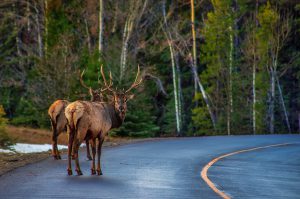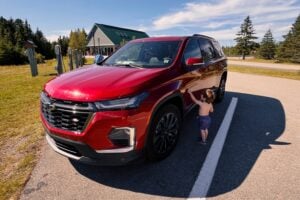
Wildlife
Why won’t wolverines cross the road?
In shedding light on wolverines’ aversion to roads, new research suggests the key to their conservation in Alberta
- 844 words
- 4 minutes
Travel
Discover hidden hotels, hearty local cuisine and out-of-this-world landscapes on a nine-day self-guided tour of Norway’s network of National Scenic Routes

“Seventeen, eighteen … nineteen!” My friend Michel and I are counting waterfalls we can see while soaking in a steaming wood-fired outdoor hot tub. Called Norway’s “white veins,” the falls plummet down sheer fiord walls on either side of the lush, narrow green rural valley where we are staying in a stylishly-renovated 350-year-old farmhouse inn.
“We’re all about ‘slow travel’ here,” says Tone Ronning Vike, one of the owners of 29/2 Aurland, an old family retreat that specializes in hiking, trout and salmon fly fishing, traditional row boating and relaxing. After a sauna, we dine in front of a blazing fire in the converted smokehouse on a hyper-local meal that begins with Jerusalem artichoke soup and smoked moose. Then we bed down to the sound of waterfalls and sheep bells.

Travelling slowly with frequent detours off the main tourism path is the goal on this, our first trip to Norway. We want to explore the popular Western Fiords, a labyrinth of spectacular deep blue, glacier-carved fiords that snake inland amid towering snow-capped mountains. Outdoor activities, Norway’s unique architecture, culture and cuisine are our top priorities. To travel at our own pace and be able to stop on a whim, we choose a nine-day independent self-drive road trip with a loose itinerary that ends each day at remarkable accommodations — timber lodges, manors and old coaching inns transformed into romantic lodgings or chic contemporary outposts hidden in forests, all run by passionate locals.
We land in Bergen, Norway’s scenic second-biggest city on the southwest coast and are already counting waterfalls on our way in from the airport as we drive among a stream of electric cars, which make up 33 per cent of the traffic here. With a population of 272,000, Bergen has a charming, small-town feel, with its colourful medieval Hanseatic wharf area called Bryggen — a UNESCO World Heritage Site — lining one side of Vågen Harbour. On the other side, a lively fish market showcases the fresh offerings of the world’s second-biggest seafood supplier.
Bergen is the gateway to fiord country. We wind our way effortlessly out of the city, noting the absence of billboards and garish commercial signs, which are banned. We pass the small town of Dale, birthplace of Norway’s famed knitted sweaters. It begins to rain enthusiastically, sending new waterfalls tumbling down steep cliffs – some right onto the roadside. Sheep graze bright green fields alongside ornate farmhouses. Moss and grasses sprout from the roofs of roadside bus shelters, old cabins and post-boxes. We meander through countless tunnels.
In 1994, the Norwegian government, in a move ahead of its time, designated 18 National Scenic Routes throughout the country to entice travellers away from busy tourist areas and to bring attention and commerce to beautiful, little-visited towns and landscapes. To make the remote routes even more appealing, they launched nationwide architectural, landscaping and art competitions, with the winning entries placed along these wilderness roads.
By the time the 30-year project draws to a close in 2023, there will be a remarkable collection of 200 viewpoints, visitors’ centres, walkways, picnic areas and rest pavilions, some well above the Arctic Circle.

Our first detour is onto the Hardanger National Scenic Route for a glimpse of an ultra-chic toilet block (!) with a floor-to-ceiling glass wall overlooking spectacular Skjervsfossen waterfall.
Soon we are alongside one of the octopus arms of Sognefjord, Norway’s deepest (1,308 metres) and longest (205 kilometres) fiord (a Norwegian word). The wildest and narrowest arm of that fiord, Nærøyfjord, is a UNESCO World Heritage Site. The site’s gateway is the town of Flam, where we sip a cold IPA at the Viking-inspired Ægir craft brewery.
While Norway is still less touristed than many European countries, visitor numbers have boomed since Disney’s 2015 animated blockbuster Frozen, which is set on a Norwegian-like fiord; the 2019 sequel will surely lead to another significant increase in tourism. Already, Flam’s 230 residents see about half a million visitors and nearly 200 cruise ships annually.
It is numbers like this that inspired journalist Tone Ronning Vike and her husband to convert his family’s farm into 29/2 Aurland. Just a few kilometres from busy Flam, it’s a solitary getaway. Tone often hikes with guests to the biggest local waterfall. She serves potatoes from Norway’s only school of organic agriculture nearby, goat cheese from local farmers and reindeer meat and mountain trout from indigenous Sami hunters and fishermen.
The following morning, we zigzag up the steep Aurlandsfjellet National Scenic Route, where farms are perched on the narrowest mountain ledges. Reaching the stunning Stegastein viewing platform, we literally walk out over the edge of the dramatic, narrow fiord.
The route then plummets into the world’s longest road tunnel, 24 kilometres long. At the halfway point, a funky-coloured lighting display at a pullout is a much-anticipated attraction to keep drivers awake. Norway has an astonishing 1,400 tunnels, third in the world after China and Japan.
We pop out of the mountain at the charming old-world town of Lærdal, whose nearby Borgund stave church was built in 1250 AD.
Winding deeper and deeper into the spectacular labyrinth of fiords, we drive a roller coaster network of roads built in the 1980s and 90s when Norway’s economy boomed, reaching the village of Mundal which, until 1986, was only accessible by boat. An unpretentious little farming town, its 300 residents are greatly outnumbered by a whopping 150,000 used books, which are stacked in old ferry waiting areas, sheds, grocery stores, cafes, on outdoor book shelves and even fill a vintage phone booth.
Dinner that night at the 15-room Fjaerland Hotel is divine — down-the-road-local duck, smoked trout, cider and a neighbour’s plum dessert wine, which we sip overlooking the fiord waters and the icy blue tongue of Jostedals Glacier, mainland Europe’s biggest.

The following day finds us in Loen, where we whiz up the small town’s new Skylift gondola, watching climbing enthusiasts tackle the fixed-route Via Ferrata alongside. We hike around the summit, taking in spectacular views up and down a tangle of fiords. Rain swoops down one fiord while sun shines upon another. Rainbows constantly bloom and fade.
That night in the family-owned Hotel Alexandra we dine on their famed dinner buffet, a decadent expanse including cod, langoustine and monkfish, local lamb and reindeer roasts.
With a high standard of living, Norway is an expensive country to visit. Alcohol is particularly costly, especially in restaurants, but over and over again we are told by Norwegians that they are happy to pay the social democratic country’s high tax rates to cover free university, child care, and maternity and paternity leaves. “Drink more,” one fellow tells us, laughing, “you’re paying for my retirement.”

The next day we drive from autumn smack up into mid-winter on the 104-kilometre Geiranger-Trollstigen National Scenic Route, one of the country’s most spectacular routes and another UNESCO World Heritage Site. Suddenly we are in the Arctic, picking wild blueberries on tundra amid sheer bluffs and ankle-deep snow where traces of stone bridges from the original 1889 road remain. We stop at frequent viewpoints including the modern glass Ørnesvingen waterfall/viewpoint as the route zigzags down towards the mountain town of Geiringer.
We often hop on brief ferry rides across inlets on our route, including one to reach the second part of this National Scenic Route, the Trollstigen – “Trolls Path.” It’s a marvellously serpentine mountain road with a chic angular visitors’ centre at the summit, blending stylishly with the sheer rock walls. Glass balcony viewpoints create the feeling that you’re hanging out over the fiord looking down on the 11 dizzying hairpin turns that will take us down towards the next fiord and towns.
After all that cliff-side adrenalin it is a relief to pull into the tranquil green landscape of Burtigarden Farm, site of the Juvet Landscape Hotel, one of the trip’s highlights. Owner Knut Slinning hands us a key to one of the seven ultra-modern cubes on stilts, small and simple wooden cabins tucked amid the woods and overlooking a bend in the Valdolla River. The ceiling to floor glass windows onto lush forest make it hard to tell whether we are inside or out. Along with its grass-roofed spa, the Juvet was the setting for the 2014 British science-fiction film Ex Machina. In contrast to the contemporary lodgings, dinner is served in a restored 1914 barn, where guests mingle at a communal table.

We end up back on Norway’s west coast in the Art Nouveau town of Ålesund, a major fishing centre, where the fiords meet the sea. Our hotel, the Brosundent, has incorporated the original heavy wooden beams from its days as a salt cod storage warehouse into luxury lodgings.
Norway is an easy country to traverse by car on your own. Virtually everyone speaks English and locals are eager to make sure visitors have a great experience… all good reasons to travel to Norway now. Besides, who wouldn’t want to spend time in a place that routinely ranks among the most contented countries on the annual United Nations’ World Happiness Reports?
All prices in CAD$
50 Degrees North: Run by experienced Scandinavians, the company offers a catalogue of customized tours including independent self-drive itineraries that reach deeper into less-explored countryside. The Norway by Design and History Tour is a flexible nine-day fiord and coastal Norway package with an emphasis on unique accommodations, architecture, art and outdoor activities. Car, hotels, breakfasts and dinners are included. May 1–September 30, 2020. From $3,750 per person, based on double occupancy.
Driving in Norway: Roads are excellent. However, during the peak season (July-early August) routes can be crowded and there may be waits for ferries. June and September are cooler, but less crowded.
29/2 Aurland: Genteel, family-run luxury B&B on a famed fly-fishing river with antique and modern furnished accommodations ranging from a historic fisherman’s cabin to suites in an early-18th century goat barn. Full breakfast included. From $660 double per night — two night minimum — with organic, gourmet breakfast, afternoon tea and 3-course farm-to-table dinner in converted smokehouse included.
Juvet Landscape Hotel: Seven separate contemporary, minimalist pine and glass “cubes” designed to blend into the surrounding nature reserve. Set on a farm, the main building is a historic farmhouse. From $365/double including breakfast. Farmhouse gourmet 3-course dinner $95 per person.
Are you passionate about Canadian geography?
You can support Canadian Geographic in 3 ways:

Wildlife
In shedding light on wolverines’ aversion to roads, new research suggests the key to their conservation in Alberta

Environment
An estimated 29 million mammals are killed each year on European roads

Travel
Nine amazing summer drives we recommend

Travel
Discovering boats, buoys and deep-fried clams on an epic family road trip in the 2022 Chevrolet Traverse RS